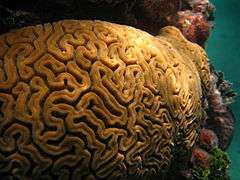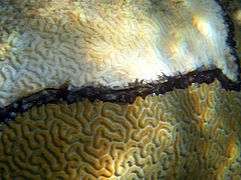Diploria labyrinthiformis
| Diploria labyrinthiformis | |
|---|---|
 | |
| Diploria labyrinthiformis | |
| Scientific classification | |
| Kingdom: | Animalia |
| Phylum: | Cnidaria |
| Class: | Anthozoa |
| Order: | Scleractinia |
| Family: | Mussidae |
| Genus: | Diploria |
| Species: | D. labyrinthiformis |
| Binomial name | |
| Diploria labyrinthiformis (Linnaeus, 1758)[2] | |
Diploria labyrinthiformis, known by the common name grooved brain coral,[2][3][4] is a species of stony coral in the family Mussidae.[5][6][7][8] Found in tropical areas of the west Atlantic Ocean, it has a familiar, maze-like appearance.
Description

This species of reef-building coral has a hemispherical, brain-like shape with a brown, yellow, or gray colour.[3] It has characteristic deep, interconnected double-valleys. These polyp-bearing valleys are each separated by grooved ambulacral ridges. There may be a difference in colour between the valleys and the grooves.[9]
Diploria labyrinthiformis can grow upward at a rate of approximately 3.5 millimeters per year, achieving about 2 metres (6.6 feet) in diameter. During its planktonic larval stage, the coral has locomotion. After that time, it becomes permanently sessile.[10]
This species is a suspension feeder, and survives mainly on zooplankton and bacteria. These are captured by the polyps, by extruding mesenterial filaments and tentaces. The polyps have nematocysts which are triggered to hold their prey immobile. The prey is then transported to the mouth with the assistance of mucus and cilia.[10]
Diploria labyrinthiformis is hermaphroditic, and reproduces through brooding. This entails the egg being fertilized by the sperm within the polyp, followed by the release of the larvae.[10]
Distribution and habitat
Diploria labyrinthiformis is found in tropical parts of the west Atlantic Ocean, the Gulf of Mexico, the Caribbean Sea, the southern tip of Florida, the Bahamas, Bermuda and the coasts of Central America.[1][2][11]
This coral occurs offshore at depths ranging from 1 to 30 metres (3.3 to 98.4 feet).[10]
Relationships with other species
Symbiotic
Diploria labyrinthiformis hosts Zooxanthella, a symbiotic dinoflagellate alga. The alga benefits from being in a protective environment in an elevated position. The coral benefits from the nutrients produced photosynthetically by the alga which provides part of its needs for growth and calcification.[10]
The coral also has a relationship with Diadema antillarum, the long-spined urchin, whose grazing helps to reduce the effects of shading, as well as the overgrowth of macroalgae.[10]
Predators
Despite the polyps being equipped with nematocysts, various species prey upon Diploria labyrinthiformis. These include:[10]
- Gastropods
- Polychaetes (annelid worms)
- Sea urchins
- Starfishes
- Sea spiders
- Parrotfish and other fishes
Parasites
This species is host to a parasite in the Corallovexiidae family:[2]
- Corallovexia brevibrachium, Stock 1975 is both an ectoparasite and an endoparasite.

Postage stamps
Images of Diploria labyrinthiformis appear on two postage stamps: a 75 cent Belizian stamp created by Georges Declercq,[12] and a 54 Euro cent stamp from Mayotte.[13]
See also
- Brain coral
- Colpophyllia natans (large-grooved brain coral)
References
- 1 2 Aronson, R.; Bruckner, A.; Moore, J.; Precht, B. & E. Weil (2008). "Diploria labyrinthiformis". IUCN Red List of Threatened Species. Version 2012.2. International Union for Conservation of Nature. Retrieved 30 October 2012.
- 1 2 3 4 "WoRMS - World Register of Marine Species - Diploria labyrinthiformis (Linnaeus, 1758)". Marinespecies.org. Retrieved 2011-12-19.
- 1 2 "Marine Species Identification Portal : Grooved brain coral - Diploria labyrinthiformis". Species-identification.org. Retrieved 2011-12-19.
- ↑ "Diploria labyrinthiformis (grooved brain coral) | Natural History Museum". Nhm.ac.uk. Retrieved 2011-12-19.
- ↑ Grooved Brain Coral, Diploria labyrinthiformis. Retrieved 2011-12-25.
- ↑ Coralpedia - Diploria labyrinthiformis. Retrieved 2011-12-25.
- ↑ Diploria labyrinthiformis (grooved brain coral) | Natural History Museum. Retrieved 2011-12-25.
- ↑ Marine Species Identification Portal : Grooved brain coral - Diploria labyrinthiformis. Retrieved 2011-12-25.
- ↑ "Coralpedia - Diploria labyrinthiformis". Coralpedia.bio.warwick.ac.uk. Retrieved 2011-12-19.
- 1 2 3 4 5 6 7 Kate Rossi-Snook & Dr. James B. Wood. "Grooved Brain Coral, Diploria labyrinthiformis". Thecephalopodpage.org. Retrieved 2011-12-19.
- ↑ Diploria labyrinthiformis Corals of the World. accessdate=2011-12-26
- ↑ "WoRMS - World Register of Marine Species". Marinespecies.org. 2008-11-07. Retrieved 2011-12-19.
- ↑ "WoRMS - World Register of Marine Species". Marinespecies.org. 2011-11-01. Retrieved 2011-12-19.

